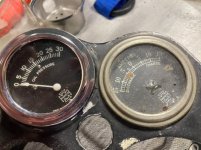Those are usually done with offset printing, black ink on a matte white aluminum sheet.
Decades ago I worked for an electrical instrument manufacturer and that is how it was done. Most of our gauge faces were black markings on white but we also had some customers who wanted the white markings on black, which was done by making a negative of the artwork.
We had some customers who wanted colored bars as well and this was done by secondary printing operations. We made whatever the customer wanted, with a lot of 4-20mA process meters with some really weird scales such as cubic yards per second.


